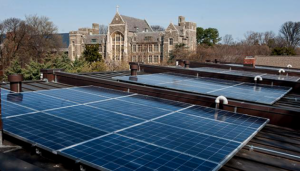Georgetown University’s plans to build a solar power facility in Maryland that would clear-cut 240 acres of forest have drawn calls from local environmentalists to change the location of the proposed solar panels.
While the project would contribute to the university’s goal of halving greenhouse gas emissions by the 2019-20 academic year, it would also deforest 240 acres of land that act as a carbon sink, preventing the gas from going into the atmosphere.
Clearing the forest to install solar panels may tarnish popular support for renewable energy, according to Bonnie Bick, an activist in the Southern Maryland chapter of the Sierra Club, a national environmental preservation organization.
“This is counterproductive for solar in general because it gives solar a bad name,” Bick said in an interview with The Hoya. “This is not where solar should be located. And by locating it here, they are doing a disservice to solar because the negative impacts are unacceptable.”
A university spokesperson declined to comment on whether the university was changing the location of the solar project.

Georgetown first partnered with Origis Energy USA, a solar energy company, in September 2017 to build the La Plata, Maryland 32.5-megawatt off-site solar power system. The panels would produce 75,000 megawatt hours of power each year and provide for about 50 percent of the university’s energy needs in the 2019-20 school year, according to a company press release. Origis estimates the project will be operational by June 2019.
Georgetown should have included student voices more in the development of its solar project, as many are unsure of their support of the placement of the panels, according to Samantha Panchèvre (SFS ’19), Georgetown University Student Association senior sustainability chair.
“If the University had been intentional about engaging students and communicating the rationale for choosing La Plata as well as the benefits this specific site would bring, then I think students would feel a lot more comfortable with this project — but most of us are in the dark, so we can’t fully support it,” Panchèvre wrote in an email to The Hoya.
The Georgetown Environmental Leaders Network, managed by the GUSA Sustainability division, is set to hold a public forum to gather more student perspectives on the project Feb. 10.
Georgetown is committed to halving its greenhouse gas emissions by 2020 and will conduct ongoing reviews of the project, according to a university spokesperson.
“We’re engaging a third party expert to assess the existing, extensive studies and review of this offsite solar project to ensure it is conducted in an ecologically responsible way,” the spokesperson wrote in an email to The Hoya.
The project’s reduction in greenhouse gas emissions would be similar to planting 429,000 trees, the spokesperson wrote. This estimate was found using the Environmental Protection Agency’s emissions reduction calculator.
While installing renewable energy is important, efforts should not be implemented without regard to other environmental considerations, Sierra Club member and nearby resident Ben Hance wrote in an email obtained to GU Fossil Free, a club pushing for the university to divest from non-renewable energy,
“Renewable energy is the future, but its growth must be the result of a thoughtful process that accounts for more than just the carbon balance sheet for electricity usage,” Hance wrote in an email obtained by The Hoya.
The area has been named “the best of the best” by the Department of Natural Resources, and was designated as an Important Bird Area for its role as a habitat for the state’s rarest plants and animals, according to the Maryland Audubon Society, a group that works to protect the habitats of birds.
Origis plans to permanently limit use of more than half of the 537 acres it purchased for conservation purposes. The company also plans to conserve that land through building a habitat and protecting waterways, according to the company’s proposal to the Maryland Public Service Commission.
Origis chose the location because the land was unfarmed, the company could gain a permit to install solar panels and power lines were nearby, according to Origis spokesperson Glenna Wiseman.
The proposal was unanimously approved by the Charles County Board of Appeals, though a motion for reconsideration was denied, Wiseman wrote in an email to The Hoya.
As part of the agreement, Origis plans to contribute to scholarships for low-income undergraduate students with demonstrated financial need.
The project is critical to Georgetown’s sustainability and carbon emissions goals, according to Robin Morey, vice president of Planning and Facilities Management.
“This strategic partnership with Origis supports Georgetown’s carbon footprint reduction goals while providing long term energy price stability,” Morey said in a Sept. 18 statement announcing the project.
Still, Georgetown should change the location of this solar project due to the environmental harms of deforesting land, Lisa Redding, a resident near the planned site who has been vocal of her opposition, wrote in an email to The Hoya.
“Georgetown University can direct their contractor to find a better location,” Redding wrote. “It may be cheap for Origis to destroy forests but the loss to society is not.”




















